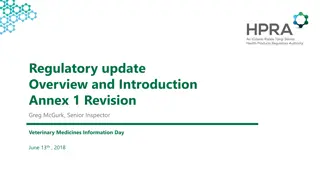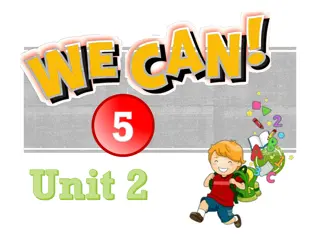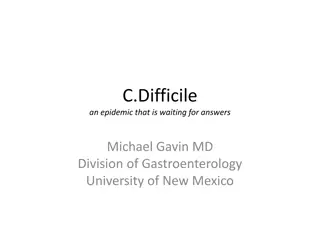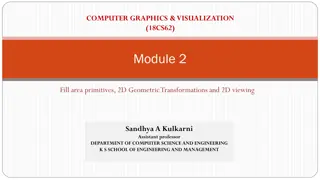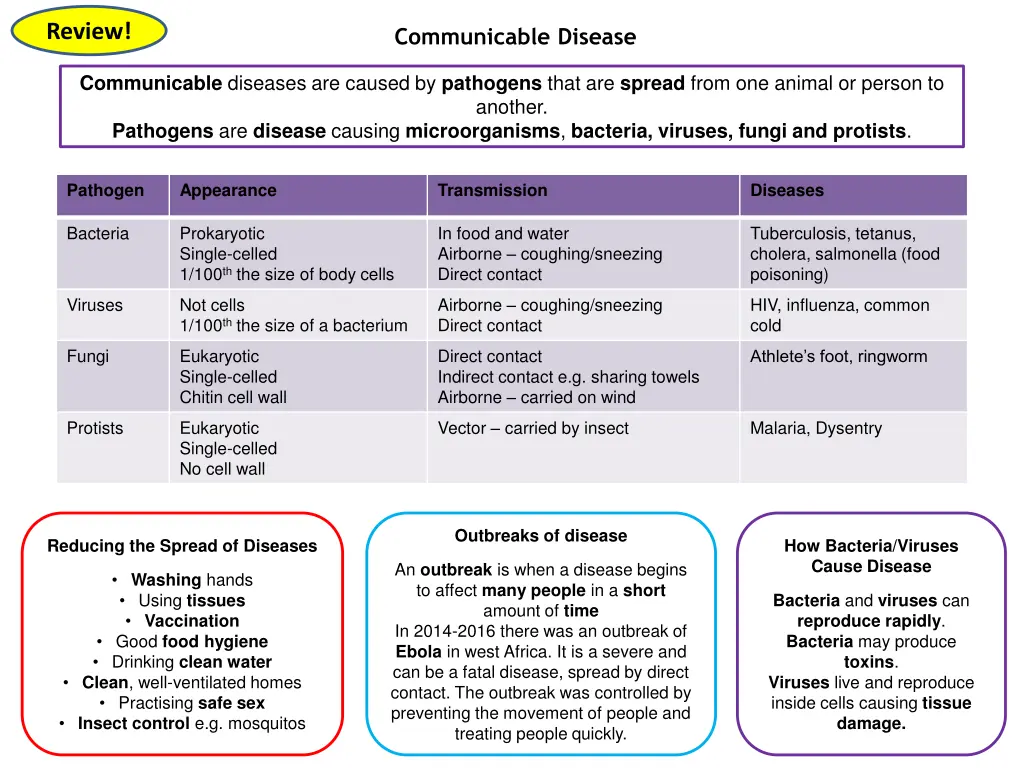
Understanding Communicable Diseases: Causes, Transmission, and Prevention
Learn about communicable diseases caused by pathogens like bacteria, viruses, fungi, and protists. Explore how these pathogens appear, transmit, and lead to diseases. Discover ways to reduce the spread of diseases and how bacteria and viruses cause outbreaks. Delve into specific examples of viral, bacterial, fungal, and protist diseases with their symptoms and prevention methods. Understand the human body's defense systems against pathogens, including non-specific and specific immune responses.
Uploaded on | 1 Views
Download Presentation

Please find below an Image/Link to download the presentation.
The content on the website is provided AS IS for your information and personal use only. It may not be sold, licensed, or shared on other websites without obtaining consent from the author. If you encounter any issues during the download, it is possible that the publisher has removed the file from their server.
You are allowed to download the files provided on this website for personal or commercial use, subject to the condition that they are used lawfully. All files are the property of their respective owners.
The content on the website is provided AS IS for your information and personal use only. It may not be sold, licensed, or shared on other websites without obtaining consent from the author.
E N D
Presentation Transcript
Review! Communicable Disease Communicable diseases are caused by pathogens that are spread from one animal or person to another. Pathogens are disease causing microorganisms, bacteria, viruses, fungi and protists. Pathogen Appearance Transmission Diseases Bacteria Prokaryotic Single-celled 1/100th the size of body cells In food and water Airborne coughing/sneezing Direct contact Tuberculosis, tetanus, cholera, salmonella (food poisoning) Viruses Not cells 1/100th the size of a bacterium Airborne coughing/sneezing Direct contact HIV, influenza, common cold Fungi Eukaryotic Single-celled Chitin cell wall Direct contact Indirect contact e.g. sharing towels Airborne carried on wind Athlete s foot, ringworm Protists Eukaryotic Single-celled No cell wall Vector carried by insect Malaria, Dysentry Outbreaks of disease Reducing the Spread of Diseases How Bacteria/Viruses Cause Disease An outbreak is when a disease begins to affect many people in a short amount of time In 2014-2016 there was an outbreak of Ebola in west Africa. It is a severe and can be a fatal disease, spread by direct contact. The outbreak was controlled by preventing the movement of people and treating people quickly. Washing hands Using tissues Vaccination Good food hygiene Drinking clean water Clean, well-ventilated homes Practising safe sex Insect control e.g. mosquitos Bacteria and viruses can reproduce rapidly. Bacteria may produce toxins. Viruses live and reproduce inside cells causing tissue damage.
Review! Viral, Bacterial, Fungal & Protist Disease HIV Viral Spread by bodily fluids, e.g. sexual contact. Symptoms initially flu like, but may not have symptoms for years. Can be controlled with antiretroviral drugs, to prevent replication. The virus attacks the immune cells. AIDS later stage body can t cope with infection. Tobacco Mosaic Plant Virus Measles Viral Spread by droplets sneeze/cough Symptoms red skin rash and fever Most people are vaccinated against measles when they are young. If there are complications they can be serious or fatal. Affects many plants e.g. tomatoes Symptoms discolouring of leaves mosaic pattern. Due to the discolouration, there is less photosynthesis and therefore less growth. Gonorrhoea Bacterial STD Salmonella Bacteria (food poisoning) Spread by sexual contact Spreads via contaminated food, either by poor hygiene or when the chicken caught the disease when it was alive. Symptoms fever, stomach cramps, vomiting, diarrhoea. The bacteria release toxins which cause the symptoms. In the UK most chickens and turkeys are given a vaccination against Salmonella to control the spread of the disease. Symptoms pain when urinating, thick yellow or green discharge from penis or vagina. The spread can be prevented by treating people with antibiotics, using barrier methods of contraception e.g. condoms. Antibiotic resistance has made this trickier to treat Malaria Protist Rose Black Spot Plant Fungus Part of the malarial protist life cycle takes place inside the mosquito. Mosquitos pick up the malarial protist when they feed on an infected animal, they are vectors. When the mosquito feeds on another animal, it infects it by inserting the protist into the animals blood vessels. Symptoms repeating episodes of fever, can be fatal. The spread can be reduced by preventing mosquitos breeding and using mosquito nets. Spreads in the water and by the wind. Symptoms purple or black spots develop on the leaves. The leaves then turn yellow and drop off. There is less photosynthesis and less growth. Treated by fungicides or stripped affected leaves and destroying them.
The initial immune response can take a little time to get going re-infection is quicker to deal with by the immunesystem . Review! Human Defence Systems The body has many different types of defence against pathogens. There are non-specific defence systems to prevent them getting into the body, and if they do get in then there are two types of white blood cell that can destroy them this is the specific immune system. Non-Specific - Prevention The human body has features (non- specific defences) to prevent pathogens getting into the body in the first place. Specific Immune Response Phagocytosis Skin physical barrier against pathogens. Any cuts form a scab. Secretes antimicrobial substances to kill pathogens. Nose hairs and mucustrap particles and pathogens. Trachea and bronchi mucus traps pathogens and is moved up to the throat by small hairs called cilia. Stomach hydrochloric acid and protease enzymes in the stomach kill pathogens. Phagocytes are a type of white blood cell that can engulf (take it inside) any type of pathogen. They do this by extending their membrane around the pathogen until it is surrounded. The pathogen enters the phagocyte and is digested by enzymes. This is called phagocytosis. A lobed nucleus Pathogen digested by enzymes Phagocytosis Phagocytes engulf pathogen .. .. . Antibodies bind to antigens Specific Immune Response Lymphocytes: Antibody and Antitoxin Antigens A white blood cell recognises when to attack by the markers on the surface of membranes called antigens . It recognises your own cells as self and pathogens as foreign When some lymphocytes come across a foreignantigen they produce antibodies (a type of protein), which attach to the pathogen, preventing them from entering cells and also clumping them together so the phagocytes can engulfmany at once. The antibodies are specificto that type of antigen, they won t work against other pathogens. If the body is infected again (later) with the same pathogen the response is much quicker as the pathogen will be recognised. Lymphocytes also produce antitoxins they attach to toxins produced by the invading bacteria. There are lots of different antigens
Herd immunity when most are vaccinated it protects the few that are not Review! Vaccination Preventing Disease How does Vaccination Work? When people are infected with a new pathogen, it takes a few days for the white blood cells to learn how to deal with it, but in that time the person will feel quite ill. A vaccine contains a small amount of dead or inactive pathogen carrying the antigens, these are injected into the persons bloodstream. The inactive pathogen is harmless and does not cause the disease, but as it contains the antigens it triggers the immune response as usual. The white blood cells called lymphocytes produce antibodies to bind to the pathogen, the phagocytes engulf them. If the vaccinated person does become infected with the pathogen, the immune response is a lot quicker at dealing with it the second time around, the pathogen is removed without the person becoming ill. Lymphocytes produce antibodies, phagocytes engulf pathogen If same pathogen infects person, immune response is very quick Inactive pathogen carrying antigen injected Vaccination Programmes Pros and Cons of Vaccination Most people in the UK are vaccinated against a number of pathogens. Some people cannot be vaccinated. Herd immunity is when most of the population are vaccinated, this protects the few people that cannot be vaccinated as the disease is less likely to be able to spread through the population. Many diseases are now undercontrol. Smallpoxno longer occurs at all and polio is now very rare. Big outbreaks are unlikely epidemics, populations are protected by herd immunity But vaccinesdon talways work and can sometimes cause bad reactions although this is rare.
Review! Antibiotics only treat bacteria!! Antibiotics and Painkillers Antibiotics Painkillers Antibiotics such as penicillin are medicines that destroy or inhibit the growth of bacteria. They treat bacterial infections only, not viruses!! Specific bacteria are killed by a specific antibiotic so the doctor must prescribe the correct one. Painkillers such as aspirin can be used to treat the symptoms of disease, but do not treat the disease itself. Antiviral drugs are medicines used to treat diseases caused by viruses, they stop the virusmultiplying and spreading. Viruses are difficult to treat as they move into body cells, so killing a virus could damage the cells. Antibiotic Resistance The use of antibiotics has greatly reduced deaths from infectious bacterial diseases. However some bacteria are developing resistance to antibiotics which is a big concern as they cannot be treated with antibiotics. This can be reduced by only prescribing antibiotics when necessary and always finishing the course prescribed. How resistance develops: Mutations can lead to a resistant bacterial strain (cannot be killed by antibiotic) Infected person that also has a resistant strain takes an antibiotic that only kills the non- resistant strain. XX The population of resistant bacteria increase this is an example of natural The resistant bacteria no longer have competition for nutrients etc. X The new resistant strain may cause a serious infection e.g. MRSA selection
Mutations are changes in DNA that can lead to a change in a physical characteristic e.g. a stronger cell membrane. * Review! Antibiotic Resistance Mastery Mutations can lead to a resistant bacterial strain (cannot be killed by antibiotic) * Note mutations can also result in no effect, or a bad effect for the organism (the result is not always beneficial). Infected person that also has a resistant strain takes an antibiotic that only kills the non- resistant strain. X X X Not every mutation leads to antibiotic resistance , also not every antibiotic resistant strain leads to a superbug. But when resistant strains like MRSA do arise, it can lead to many deaths. The resistant bacteria no longer have competition for nutrients etc. The population of resistant bacteria increase this is an example of natural selection
Review! Developing Drugs There are Three Main Stages in Drug Testing Remember CAV Cells then Animals then Volunteers 1 1) In preclinical testing, drugs are tested on human cells and tissues in the lab. (However this can t be used to test drugs that affect whole or multiple body systems, e.g. drugs for blood pressure rely on circulatory system). Traditionally new drugs were discovered by extracting compounds from plants or microorganisms. Examples: The painkilleraspirin comes from willow bark. The heart drug digitalis comes from foxgloves. Penicillin comes from the Penicillium mould. 2 1) The next step in preclinical testing is to test the drug on live animals. This is to test efficacy (whether the drug works does what you intend). This helps find out about the toxicity (causing harm) and to find the best dosage (what concentration and how often). 2) A second live mammal must be tested upon this is the British law. 1) If the drug passes the previous stage it can be tested on human volunteers in a clinical trial. 2) First healthy volunteers are tested (to ensure no side effects). 3) If the results are good, the drugs are tested on people with the illness. The optimum dose is found, the dose of drug that is the most effective and has few side effects. 4) To test how well the drug works, patients are randomly put into two groups. One is given the new drug, the other is given a placebo (looks like a pill but does not contain medicine). So the doctor can see the real difference the drugs make sometimes people think they feel better just because they are taking medicine, even through the treatment is not having any effect this is called the placebo effect. 5) Clinical trials are often blind the patient in the study does not know whether they are getting the drug or the placebo. They also can be double-bind the doctor doesn t know either! 6) The results of drug testing and trials are aren t published until they are peer reviewed this helps to prevent false claims. 3
Monoclonal antibodies are made by white blood cells called lymphocytes. Review! Monoclonal Antibodies Monoclonal Antibodies are Specific 1) Mouse is injected with an antigen. This method can be used to make a largeamount of monoclonalantibodies, which can be collected and purified. 2) This stimulates one of the mouse lymphocytes to form many clones of itself. You can make monoclonal antibodies that bind to any type of cell you want, by using the antigen found on the type of cell you want to target. 3) The cloned lymphocytes make antibodies that are complementary to the antigen. All of the monoclonal antibodies are identical They will only bind to that that antigen so are really useful to target certain cells or chemicals in the body. 4) The lymphocytes (which can make the specific antibody) are combined with a type of tumour cell (as they divide a lot) to make a hybridoma cell (which can do both). What do Monoclonal Antibodies Bind To? Monoclonal antibodies have a specific Y shape that binds only to the binding site on the antigen. The antigen can be a protein. The shape of the antibody is complementary to the shape of the bindingsite. This means that the antibodies cannotbind to any other antigen, so can be used to target a particular cell, chemical or protein in the body. 5) Hybridoma cells can divide to make many copies (clones) and make the antibody.
Uses of Monoclonal Antibodies Summary of Uses These details do not need to be learnt, but when this type of information is given, you should be able to explain how they work. Review! Diagnosis in pregnancy tests. Blood testing measure levels of hormones/ chemicals Disease detection test for presence of pathogen Research locate molecules in a cell by binding antibody with a fluorescent dye Treat diseases monoclonal antibodies are bound to a radioactive substance, drug or chemical and used to treat cancer. The antibodies bind specifically to cancer cells and do not harm healthy cells. Treating Disease Cancer cells have antigens on their cell surface not found on healthy body cells called tumour markers. Monoclonal antibodies can be produced to only bind to the tumour markers. An anti-cancer drug can be attached to these monoclonal antibodies, e.g. a radioactive drug, or a toxic drug to stop the cell growing. The antibodies are given to the patient through a drip, they bind to the tumour markers, the drug kills the cancer cell only. Blood Testing Side Effects Monoclonal antibodies are produced that will bind to the target molecule. The antibodies are bound to a fluorescent dye. If the molecules are present in the sample, they can be detected by the dye, as the antibodies (with the dye) would have attached to them. There were more side effects that expected, so they are not as widely used yet as was hoped. They cause fever, vomiting and low blood pressure. These were not expected as they target very specific cells or molecules. One big advantage of this treatment is in the use for cancer treatment, which reduces the need for chemotherapy or radiotherapy which have more side effects. Pregnancy Testing Part of the stick requires urinating on, it has antibodies on it fixed to blue beads these can move. If the person is pregnant, they have a hormone called HCG in their urine, this will bind to the antibody that is bound to the blue bead. The urine moves up the stick, carrying the hormone and the blue bead. The urine reaches the test strip that has stuck down antibodies. With HCG present it binds to the stuck down antibody and therefore turns blue. Ethical Issues The process of making the monoclonal antibodies may cause discomfort to animals, they do not choose to take part.
You only need details of these 3 Black spot affects roses, is caused by a fungus and appears as spots on leaves Review! Plant Diseases and Defences Detecting Plant Diseases Ion Deficiencies Condition Common Diseases Nitrate deficiency leads to stuntedgrowth. Nitrates are required for proteinsynthesis and therefore growth. TMV a virus affects lots of plants e.g. tomato and tobacco. Forms black mosaic pattern on leaves Stunted Growth Viral Infection Spots on Leaves Rose Black Spot Areas of decay Blight Aphids are small green insects that feed on the sap of plants. Infestations cause stunted growth and distorted leaves. Magnesium deficiency leads to chlorosis yellowing of the leaves. Magnesium ions are required to make chlorophyll for photosynthesis. Growths Cankers/galls Discolouration Tobacco Mosaic Virus Malformation Blight Presence of Pests Aphid Infestation Identification can occur by; Looking up in a book or website Take to a laboratory Using a testing kit that contains monoclonal antibodies. This information allows horticulturists to provide optimum conditions to grow plants. Chlorosis is a yellowing of the leaves which can be caused by disease, lack of sunlight or magnesium deficiency. Physical Plant Defences Chemical Plant Defences Mechanical Adaptations Some plants produce antibacterial chemicals to defend against pathogens e.g. mint. Some plants produce poisons against herbivores e.g. stinging nettles have small needle like cells on their leaves. They break off an inject irritating toxins when touched. Thorns e.g. on roses deter animals. Hairs on leaves protect plant from insects. Curling of leaves e.g. mimosa protect from herbivores. They can knock insects off or move away a little. Mimicry makes the plants flowers or leaves look like something else to trick animals. The ice family plant has some species that look like pebbles. Cellulose cell wall and waxy cuticle strong to prevent pathogens entering as a barrier. Trees have bark this is dead cell material that has lignin a waterproof substance. This acts as a barrier to pathogens.
Communicable Disease Do! Communicable diseases are caused by that are spread from one animal or person to another. Pathogens are .. causing microorganisms, bacteria, ., fungi and ... Pathogen Appearance Transmission Diseases Bacteria Prokaryotic Single-celled ..h the size of body cells In food and water Airborne coughing/sneezing contact ., tetanus, cholera, salmonella (food poisoning) Viruses coughing/sneezing Direct contact Not .. 1/100th the size of a bacterium HIV, .., common cold Fungi Direct contact contact e.g. sharing towels Airborne carried on wind Single-celled Chitin cell wall . foot, ringworm Protists carried by insect , Dysentry . Single-celled No cell wall Outbreaks of disease Reducing the Spread of Diseases How Bacteria/Viruses Cause Disease An outbreak is when a disease begins to affect .. people in a .. amount of time In 2014-2016 there was an outbreak of Ebola in west Africa. It is a severe and can be a fatal disease, spread by direct contact. The outbreak was controlled by preventing the movement of people and treating people quickly. Washing hands Using tissues .. Good food hygiene Drinking clean Clean, well-ventilated homes Practising safe sex .. control e.g. mosquitos Bacteria and viruses can rapidly. Bacteria may produce ... Viruses live and reproduce inside cells causing . damage.
Viral, Bacterial, Fungal & Protist Disease Do! HIV Viral Spread by bodily , e.g. sexual contact. Symptoms initially like, but may not have symptoms for years. Can be controlled with .. drugs, to prevent replication. The virus attacks the cells. AIDS later stage body can t cope with ... Tobacco Mosaic Plant Virus Measles Viral Spread by sneeze/cough Symptoms red skin and fever Most people are .. against measles when they are young. If there are complications they can be serious or . Affects many plants e.g. tomatoes Symptoms of leaves mosaic pattern. Due to the discolouration, there is less photosynthesis and therefore less . Salmonella Bacteria (food poisoning) Gonorrhoea Bacterial STD Spreads via contaminated , either by poor hygiene or when the chicken caught the when it was alive. Symptoms fever, stomach cramps, , diarrhoea. The bacteria release . which cause the symptoms. In the UK most chickens and turkeys are given a ..against Salmonella to control the spread of the disease. Spread by . contact Symptoms pain when urinating, thick yellow or green .from penis or vagina. The spread can be prevented by treating people with ., using barrier methods of contraception e.g. condoms. Antibiotic .has made this trickier to treat Malaria Protist Rose Black Spot Plant Fungus Part of the malarial protist life cycle takes place inside the ... Mosquitos pick up the malarial protist when they feed on an infected animal, they are . When the mosquito feeds on another animal, it infects it by inserting the protist into the animals .. vessels. Symptoms repeating episodes of . , can be fatal. The spread can be reduced by preventing mosquitos .. and using mosquito . Spreads in the water and by the . Symptoms purple or black . develop on the leaves. The leaves then turn yellow and drop off. There is less photosynthesis and less . Treated by . or stripped affected leaves and destroying them.
The initial immune response can take a little time to get going re-infection is . to deal with by the immunesystem . Do! Human Defence Systems The body has many different types of defence against pathogens. There are non-specific defence systems to . them getting into the body, and if they do get in then there are two types of white blood cell that can destroy them this is the .. immune system. Non-Specific - Prevention The human body has features (non- specific defences) to prevent . getting into the body in the first place. Specific Immune Response Phagocytosis .. physical barrier against pathogens. Any cuts form a scab. Secretes .. substances to kill pathogens. Nose hairs and . trap particles and pathogens. Trachea and bronchi mucus traps pathogens and is moved up to the throat by small hairs called . Stomach .. acid and protease enzymes in the stomach kill pathogens. Phagocytes are a type of blood cell that can (take it inside) any type of pathogen. They do this by extending their around the pathogen until it is surrounded. The pathogen enters the phagocyte and is . by enzymes. This is called . A lobed nucleus Pathogen digested by enzymes Phagocytosis Phagocytes engulf pathogen .. .. . Antibodies to antigens Specific Immune Response Lymphocytes: Antibody and Antitoxin Antigens A white blood cell recognises when to attack by the markers on the surface of membranes called . . It recognises your own cells as .. and pathogens as foreign When some lymphocytes come across a foreign antigen they produce .. (a type of protein), which attach to the pathogen, preventing them from entering cells and also clumping them together so the phagocytes can .. many at once. The antibodies are . to that type of antigen, they won t work against other pathogens. If the body is infected again (later) with the same pathogen the response is much . as the pathogen will be recognised. Lymphocytes also produce .. they attach to toxins produced by the invading bacteria. There are lots of different antigens
Herd immunity when are vaccinated it protects the .. that are not Do! Vaccination Preventing Disease How does Vaccination Work? When people are infected with a new pathogen, it takes a few for the white blood cells to learn how to deal with it, but in that time the person will feel quite . A vaccine contains a small amount of dead or inactive pathogen carrying the , these are injected into the persons . The inactive pathogen is . and does not cause the disease, but as it contains the antigens it triggers the response as usual. The white blood cells called lymphocytes produce to bind to the pathogen, the engulf them. If the vaccinated person does become infected with the pathogen, the immune response is a lot . at dealing with it the second time around, the pathogen is removed without the person becoming ... Lymphocytes produce ., phagocytes engulf pathogen If same pathogen infects person, immune response is very . Inactive pathogen carrying . injected Vaccination Programmes Pros and Cons of Vaccination Most people in the UK are vaccinated against a number of pathogens. Some people . be vaccinated. Herd is when most of the population are vaccinated, this protects the .. people that cannot be vaccinated as the disease is less likely to be able to . through the population. Many diseases are now undercontrol. Smallpoxno longer occurs at all and polio is now very rare. Big outbreaks are . epidemics, populations are protected by herd immunity But vaccinesdon talways work and can sometimes cause bad .. although this is rare.
Do! Antibiotics only treat ..!! Antibiotics and Painkillers Antibiotics Painkillers Antibiotics such as are medicines that destroyor inhibit the of bacteria. They treat bacterial infections only, not .. !! Specific bacteria are killed by a specific .. so the doctor must prescribe the correct one. Painkillers such as aspirin can be used to treat the . of disease, but do not treat the disease itself. Antiviral drugs are medicines used to treat diseases caused by .. , they stop the virusmultiplying and spreading. Viruses are difficult to treat as they move into body .. , so killing a virus could damage the cells. Antibiotic Resistance The use of antibiotics has greatly reduced . from infectious bacterial diseases. However some bacteria are developing .. to antibiotics which is a big concern as they cannot be with antibiotics. This can be reduced by only prescribing antibiotics when .. and always finishing the .. prescribed. How resistance develops: Infected person that also has a resistant strain takes an .. that only kills the non-resistant strain. XX . can lead to a resistant bacterial strain (cannot be killed by antibiotic) The resistant bacteria no longer have ..for nutrients etc. X The population of resistant bacteria . this is an example of natural The new resistant strain may cause a infection e.g. MRSA
Do! Mutations are changes in DNA that can lead to a change in a physical characteristic e.g. a stronger cell membrane. * Antibiotic Resistance Mastery Put into the correct order Infected person that also has a resistant strain takes an antibiotic that only kills the non- resistant strain. * Note mutations can also result in no effect, or a bad effect for the organism (the result is not always beneficial). X X X The population of resistant bacteria increase this is an example of natural selection Mutations can lead to a resistant bacterial strain (cannot be killed by antibiotic) Not every mutation leads to antibiotic resistance , also not every antibiotic resistant strain leads to a superbug. But when resistant strains like MRSA do arise, it can lead to many deaths. The resistant bacteria no longer have competition for nutrients etc.
Do! Developing Drugs There are Three Main Stages in Drug Testing Remember CAV Cells then Animals then Volunteers Traditionally new drugs were discovered by extracting compounds from plants or microorganisms. Examples: The painkiller .comes from willow bark. The heart drug .. comes from foxgloves. .. comes from the Penicillium mould. 1) In preclinical testing, drugs are tested on human and in the lab. (However this can t be used to test drugs that affect whole or multiple body systems, e.g. drugs for blood pressure rely on circulatory system). 1 1) The next step in preclinical testing is to test the drug on .. . This is to test efficacy (whether the drug works does what you intend). This helps find out about the . (causing harm) and to find the best .. (what concentration and how often). 2) A second live mammal must be tested upon this is the British law. 2 1) If the drug passes the previous stage it can be tested on human .. in a clinical trial. 2) First healthy volunteers are tested (to ensure no side effects). 3) If the results are good, the drugs are tested on people with the . The optimum dose is found, the dose of drug that is the most effective and has few side effects. 4) To test how well the drug works, patients are . put into two groups. One is given the new drug, the other is given a (looks like a pill but does not contain medicine). So the doctor can see the real difference the drugs make sometimes people think they feel better just because they are taking medicine, even through the treatment is not having any effect this is called the placebo effect. 5) Clinical trials are often the patient in the study does not know whether they are getting the drug or the placebo. They also can be double-bind the . doesn t know either! 6) The results of drug testing and trials are aren t published until they are . reviewed this helps to prevent false claims. 3
Monoclonal antibodies are made by white blood cells called lymphocytes. Do! Monoclonal Antibodies Put in order Monoclonal Antibodies are Specific The lymphocytes (which can make the specific antibody) are combined with a type of tumour cell (as they divide a lot) to make a hybridoma cell (which can do both). This method can be used to make a .. amount of monoclonalantibodies, which can be collected and . . You can make monoclonal antibodies that bind to any type of cell you want, by using the . found on the type of cell you want to target. The cloned lymphocytes make antibodies that are complementary to the antigen. All of the monoclonal antibodies are identical They will only bind to that that antigen so are really useful to . certain cells or chemicals in the body. Mouse is injected with an antigen. What do Monoclonal Antibodies Bind To? Hybridoma cells can divide to make many copies (clones) and make the antibody. Monoclonal antibodies have a specific Y that binds only to the binding site on the . . The antigen can be a protein. The shape of the antibody is .. to the shape of the binding site. This means that the antibodiescannot to any other antigen, so can be used to target a particular , chemical or protein in the body. This stimulates one of the mouse lymphocytes to form many clones of itself.
Uses of Monoclonal Antibodies These details do not need to be learnt, but when this type of information is given, you should be able to explain how they work. Do! Summary of Uses Diagnosis in tests. Blood testing measure levels of ./ chemicals Disease detection test for presence of pathogen Research locate molecules in a cell by binding antibody with a fluorescent dye Treat diseases monoclonal antibodies are bound to a radioactive substance, drug or chemical and used to treat . The antibodies bind specifically to cancer cells and do not harm cells. Treating Disease Cancer cells have antigens on their cell surface not found on healthy body cells called tumour markers. Monoclonal antibodies can be produced to only bind to the tumour markers. An anti-cancer drug can be attached to these monoclonal antibodies, e.g. a radioactive drug, or a toxic drug to stop the cell growing. The antibodies are given to the patient through a drip, they bind to the tumour markers, the drug kills the cancer cell only. Blood Testing Side Effects Monoclonal antibodies are produced that will bind to the target molecule. The antibodies are bound to a fluorescent dye. If the molecules are present in the sample, they can be detected by the dye, as the antibodies (with the dye) would have attached to them. There were more side effects that expected, so they are not as widely used yet as was hoped. They cause fever, vomiting and low blood pressure. These were not .as they target very specific cells or molecules. One big advantage of this treatment is in the use for cancer treatment, which reduces the need for ..or radiotherapy which have side effects. Pregnancy Testing Part of the stick requires urinating on, it has antibodies on it fixed to blue beads these can move. If the person is pregnant, they have a hormone called HCG in their urine, this will bind to the antibody that is bound to the blue bead. The urine moves up the stick, carrying the hormone and the blue bead. The urine reaches the test strip that has stuck down antibodies. With HCG present it binds to the stuck down antibody and therefore turns blue. Ethical Issues The process of making the monoclonal antibodies may cause discomfort to , they do not choose to take part.
You only need details of these 3 Black spot affects roses, is caused by a .. and appears as spots on leaves Do! Plant Diseases and Defences Detecting Plant Diseases Ion Deficiencies Condition Common Diseases TMV a . affects lots of plants e.g. tomato and tobacco. Forms black mosaic pattern on leaves Nitrate deficiency leads to .. growth. Nitrates are required for proteinsynthesis and therefore growth. Stunted Growth Viral Infection Spots on Leaves Rose Black Spot Areas of decay Blight Aphids are small green . that feed on the sap of plants. Infestations cause stunted growth and distorted leaves. Growths Cankers/galls Magnesium deficiency leads to chlorosis .. of the leaves. Magnesium ions are required to make . for photosynthesis. Discolouration Tobacco Mosaic Virus Malformation Blight Presence of Pests Aphid Infestation Identification can occur by; Looking up in a book or website Take to a laboratory Using a testing kit that contains monoclonal ... This information allows horticulturists to provide .. conditions to grow plants. Chlorosis is a yellowing of the leaves which can be caused by disease, lack of sunlight or deficiency. Physical Plant Defences Chemical Plant Defences Mechanical Adaptations Some plants produce . chemicals to defend against pathogens e.g. mint. Some plants produce .. against herbivores e.g. stinging nettles have small needle like cells on their leaves. They break off an inject irritating toxins when touched. .. e.g. on roses deter animals. Hairs on leaves protect plant from insects. Curling of leaves e.g. mimosa protect from herbivores. They can knock insects off or move away a little. . makes the plants flowers or leaves look like something else to trick animals. The ice family plant has some species that look like pebbles. Cellulose cell wall and ..cuticle strong to prevent pathogens entering as a . Trees have bark this is dead cell material that has a waterproof substance. This acts as a barrier to pathogens.









